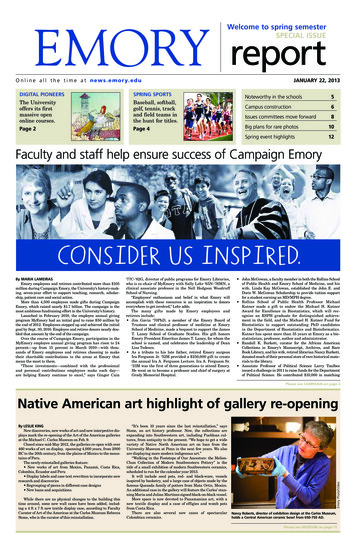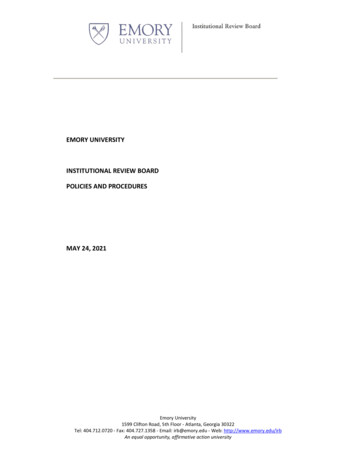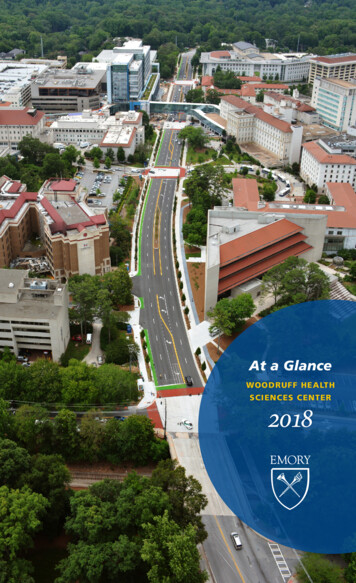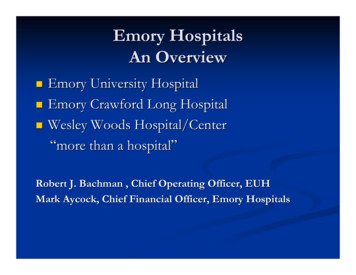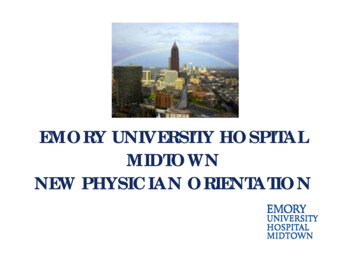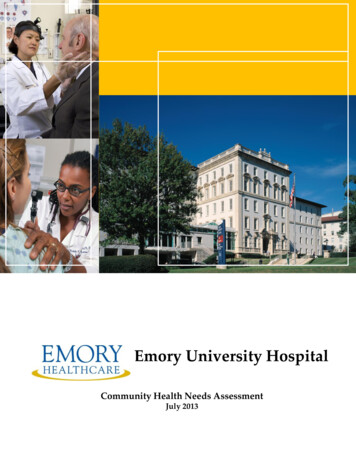
Transcription
Emory University HospitalCommunity Health Needs AssessmentJuly 2013
EMORY UNIVERSITY HOSPITALCOMMUNITY HEALTH NEEDS ASSESSMENTTABLE OF CONTENTSMessage from Emory Healthcare and Emory University Hospital .1Executive Summary .2Overview of Emory Healthcare and Emory University Hospital .3Community Health Needs Assessment Process.5Service Area Demographics .8General Health Rankings .13Mortality .15Morbidity .18General Health Measures.20Health Care Access .31Community Stakeholder Interviews .35Service Area Health Priorities .38Appendix A. Data Sources & Information Gaps .39Appendix B. Community Stakeholders Interviewed .42Appendix C. World Health Organization Cause of Disease Classifications .46
EMORY UNIVERSITY HOSPITALCOMMUNITY HEALTH NEEDS ASSESSMENTCARE, COMPASSION, SERVICEIn continuation of our commitment to the health and well-being of our community members,Emory Healthcare and Emory University Hospital are pleased to present this CommunityHealth Needs Assessment. This report assesses the needs of the community served by EmoryUniversity Hospital using quantitative data and input from individuals representing the broadinterest of the community. Using this report, Emory University Hospital identified threeprimary health needs of our community: Improve access to care in the community and collaborate with community partners tolessen the barriers to obtaining care Expand community awareness of healthy behaviors and available resources/care settingsthrough education and community based programs Increase the focus on preventative care and disease management for chronic conditions inthe community and hospital staff and improve the health of the community and hospitalstaff with a specific focus on diabetes, cardiovascular disease, stroke, and cancerEmory University Hospital developed strategies to outline how we plan to address theidentified health needs of the community we serve. Through these strategies, EmoryUniversity Hospital strives to improve the overall health of our community, while deliveringthe best possible care to our patients.We consider it a privilege to care for the health needs of the people in our community. Wewant to continue making improvements and delivering the care you need, which is why thisCommunity Health Needs Assessment will play an important role in directing the care weprovide in the future.Thank you for entrusting us with your health and the health of your family.John T. FoxPresident & CEO, Emory HealthcareRobert J. BachmanCEO, Emory University Hospital & Emory University Orthopaedics & Spine HospitalJuly 2013Page 1
EMORY UNIVERSITY HOSPITALCOMMUNITY HEALTH NEEDS ASSESSMENTEXECUTIVE SUMMARYEmory University Hospital (EUH) has proudly served the health care needs of our neighborssince 1905. EUH is a 579-bed adult, tertiary care facility. Emory University Orthopaedics &Spine Hospital, an extension of EUH’s acute care services, is a 120-bed facility that providesmedical and surgical care for orthopaedic and spine patients as well as general acute care forpatients with nonsurgical needs. As a not-for-profit academic medical center, EUH iscommitted to providing the best care for our patients, educating health professionals andleaders for the future, pursuing discovery research, and serving our community.To understand the needs of the community we serve, EUH conducted a Community HealthNeeds Assessment using quantitative data (e.g., demographics data, mortality rates, morbiditydata, disease prevalence rates, health care resource data, etc.) and input from stakeholdersrepresenting the broad interest of our community (e.g., individuals with special knowledge ofpublic health, the needs of the underserved, low-income, and minority populations, the needsof populations with chronic diseases, etc.). Using the Community Health Needs Assessment,EUH identified the following priority health needs for our community: Improve access to care in the community and collaborate with community partners tolessen the barriers to obtaining care Expand community awareness of healthy behaviors and available resources/care settingsthrough education and community based programs Increase the focus on preventative care and disease management for chronic conditions inthe community and hospital staff and improve the health of the community and hospitalstaff with a specific focus on diabetes, cardiovascular disease, stroke, and cancerImplementation strategies were developed to outline how EUH plans to address the identifiedhealth needs of our community. Through these implementation strategies, EUH strives toimprove the overall health of our community while delivering the best possible care to ourpatients.July 2013Page 2
EMORY UNIVERSITY HOSPITALCOMMUNITY HEALTH NEEDS ASSESSMENTOVERVIEW OF EMORY HEALTHCARE AND EMORY UNIVERSITY HOSPITALEmory Healthcare (EHC) is an integrated academic health care system committed to providingthe best care for our patients, educating health professionals and leaders for the future,pursuing discovery research in all of its forms, including basic, clinical, and population-basedresearch, and serving our community. As the clinical enterprise of the Robert W. WoodruffHealth Sciences Center (WHSC) of Emory University, EHC is dedicated to the unifying corepurpose, core values, and strategic direction of the WHSC.Core Purpose: To Serve Humanity by Improving Health through integration of education,discovery and health careCore Values: Excellence, Caring, IntegrityCore values guide everyday behaviors. EHC lives by its core values in the following manner: Excellence: We are committed to continuous improvement in all that we do and strive to bea leader for others to emulate. We take pride in what we do as individuals and as part of ateam. Caring: We demonstrate concern and compassion for our patients and their families,treating each person with dignity as we attend to the needs of the mind, body, and spirit. Integrity: We practice the highest ethical standards and honor our commitments. We takepersonal responsibility and ownership for our actions and demonstrate respect for ourpatients and their families, staff, and providers. We will steward our resources wisely tofulfill our mission.Vision: To be recognized as a leading academic health system, differentiated by discovery,innovation and compassionate, patient- and family-centered care.In addition to EHC, the WHSC includes Emory University School of Medicine, Nell HodgsonWoodruff School of Nursing, the Rollins School of Public Health, the Yerkes National PrimateResearch Center, and the Winship Cancer Institute of Emory University.EHC is the largest, most comprehensive health system in Georgia and includes EmoryUniversity Hospital, Emory University Hospital Midtown, Emory University Orthopaedics &Spine Hospital, Wesley Woods Center, The Emory Clinic, Emory Specialty Associates, threejoint ventures: (1) Emory Johns Creek Hospital, Saint Joseph’s Hospital, Saint Joseph’s MedicalGroup, and Saint Joseph’s Translational Research Institute (with Saint Joseph’s HealthSystem), (2) Emory Adventist Hospital (with Adventist Health System), and (3) EmoryChildren’s Center (with Children’s Healthcare of Atlanta), and a management servicesJuly 2013Page 3
EMORY UNIVERSITY HOSPITALCOMMUNITY HEALTH NEEDS ASSESSMENTagreement with Southern Regional Medical Center. EHC is passionately committed toproviding our patients with the highest quality health care available in the world today. In2012, EHC provided 72.1 million in charity care.Emory University HospitalEmory University Hospital (EUH) is a 579-bed adult, tertiary care facility. An extension ofEUH’s acute care services, Emory University Orthopaedics & Spine Hospital, is a 120-bedfacility that provides medical and surgical care for orthopaedic and spine patients as well asgeneral acute care for patients with nonsurgical needs.EUH is long known for cardiology, cardiac surgery, orthopaedics, oncology, andneurology/neurosurgery, and it has one of the most comprehensive transplant programs in theSoutheast. In 2012, the University HealthSystem Consortium (UHC) ranked EUH 2nd forquality out of over 100 academic medical centers. Among these UHC-ranked facilities, EUHhas the highest case-mix index (a measure of complexity of illness treated). In 2012, U.S. News& World Report ranked EUH among the nation’s best hospitals in five specialties. U.S. News &World Report also ranked EUH the top hospital in Metro Atlanta.EUH’s community health needs assessment demonstrates theneeds of our community. As a tertiary care facility, EUHserves patients from throughout the state of Georgia andthe Southeast. For the purpose of EUH’s communityhealth needs assessment, EUH’s community is defined asthe contiguous area from which over 55% of EUH’sinpatient admissions originate. EUH’s community orprimary service area includes DeKalb, Fulton, Gwinnett,Cobb, Henry, and Clayton counties.EUH Primary Service AreaThe EUH service area includes DeKalb, Fulton,Cobb, Gwinnet, Henry, and Clayton counties.July 2013Page 4
EMORY UNIVERSITY HOSPITALCOMMUNITY HEALTH NEEDS ASSESSMENTCOMMUNITY HEALTH NEEDS ASSESSMENT PROCESSEmory University Hospital’s (EUH) community health needs assessment was conducted bythe Woodruff Health Sciences Center Strategic Planning Office. EUH’s community healthneeds assessment was completed in conjunction with community health needs assessments foradditional operating units and affiliates of Emory Healthcare (EHC) including: Emory University Hospital Midtown Emory Johns Creek Hospital Saint Joseph’s Hospital Wesley Woods Geriatric Hospital Wesley Woods Long-term Acute Care Hospital Emory Adventist Hospital Southern Regional Medical CenterA Steering Committee of representatives from across EHC and Emory University providedguidance and input during the development of the community health needs assessments. TheSteering Committee members included the following individuals:Community Health Needs Assessment Steering CommitteeLynda Barrett, Director, Strategic PlanningShari Capers, Associate Vice President, Strategic PlanningDiane Cassels, Executive Administrator, Winship Cancer Institute at Emory UniversityAmy Comeau, Assistant Director, Market Strategy & SupportVince Dollard, Associate Vice President, CommunicationsClaudia Hall, Director, Marketing and Physician Recruitment, Southern Regional Medical CenterBabs Hargett, Associate Administrator/Director, Quality Performance ImprovementKeeli Johnson, Manager, Strategic PlanningDennis Kiley, CEO, Emory-Adventist HospitalBrandon Luten, Planning Associate, Strategic PlanningCatherine Maloney, Associate Administrator, Emory University Hospital & Emory Orthopaedics & SpineHospitalBev Miller, Director, Community Relations, Emory Johns Creek HospitalKaren O’Donald, Director, Tax and Financial Performance InformaticsBecky Provine, Chief Nursing Officer, Emory University HospitalEmily Pugh, EHC Administrative Fellow, Saint Joseph's HospitalBarbara Reed, EHC Patient Family AdvisorWhitney Robinson, Manager, Strategic PlanningEllen Sacchi, Senior Director, Development, Emory HealthcareKaron Schindler, Executive Director, Health Sciences PublicationsJen Schuck, Assistant Administrator, Wesley Woods Geriatric Hospital and Wesley Woods Long-TermAcute Care HospitalPeggy Seckler, Compliance Director, Emory-Adventist HospitalJuly 2013Page 5
EMORY UNIVERSITY HOSPITALCOMMUNITY HEALTH NEEDS ASSESSMENTCommunity Health Needs Assessment Steering CommitteeMindy Simon, Associate General Counsel, Emory UniversitySr. Rosemary Smith, Chief Mission Services Office, Saint Joseph's HospitalBetty Willis, Senior Associate Vice President, Government and Community Affairs, Emory UniversityToni Wimby, Associate Administrator, Emory University Hospital MidtownLinda Womack, Director, State Government Affairs, Emory UniversityAdditional valuable input and guidance was provided by the leadership of EHC, theleadership of each operating unit, and the leadership of the Boards.The community health needs assessments for EHC’s operating units were completed over thecourse of 2012 and 2013. The community health needs assessment process was designed toassess the needs of the community served by each operating unit using quantitative data andinput from stakeholders representing the broad interest of the community. The communityhealth needs assessment took into account information from a variety of quantitative datasources including: The Atlanta Regional Commission Centers for Disease Control and Prevention (CDC) Centers for Disease Control and Prevention’s Behavioral Risk Factor SurveillanceSystem (BRFSS) Department of Health and Human Services’ Health Resources and Services Administration(HRSA) Department of Health and Human Services’ Healthy People 2020 Georgia Department of Public Health’s Online Analytical Statistical Information System(OASIS) Georgia Hospital Association Truven Health Analytics United States Bureau of Labor Statistics United Health Foundation’s America’s Health Rankings University of Wisconsin Population Health Institute and the Robert Wood JohnsonFoundation’s County Health Rankings & RoadmapsAppendix A contains additional information on the data sources and highlights informationgaps that impacted EUH’s ability to assess the health needs of our community.Input from stakeholders representing the broad interest of the community was obtainedthrough interviews. Interviews with seventeen organizations and one focus group wereconducted with representatives from organizations with special knowledge of: The specific health needs of EHC patients, families, and employees Public health in the community served by each EHC operating unit The specific health needs of the community served by each EHC operating unitJuly 2013Page 6
EMORY UNIVERSITY HOSPITALCOMMUNITY HEALTH NEEDS ASSESSMENT The health needs of underserved, low-income, and minority populations in the communityserved by each EHC operating unit The health needs of populations with chronic diseases in the community served by eachEHC operating unitAppendix B contains a list of organizations that provided input during the community healthneeds assessment process.Using the qualitative data and input from community stakeholders, the health needs of theoverall communities served by EHC were identified by the Steering Committee. The healthneeds were prioritized through a discussion among the Steering Committee. The EHC priorityhealth needs were utilized by each operating unit to develop the priority needs for thecommunity served by each operating unit.Implementation strategies were developed to outline how each EHC operating unit plans toaddress the identified health needs of the community it serves. The implementation strategieswere developed by leadership at each operating unit with input from the Steering Committee.The community health need assessments and implementation strategies for each EHCoperating unit were approved and adopted by the associated Boards and governing bodies.July 2013Page 7
EMORY UNIVERSITY HOSPITALCOMMUNITY HEALTH NEEDS ASSESSMENTSERVICE AREA DEMOGRAPHICSAs a tertiary care facility, EUH serves patients fromthroughout the state of Georgia and the Southeast. Forthe purpose of EUH’s community health needsassessment, the community served by EUH, or the EUHprimary service area (PSA), is defined as the contiguousarea from which over 55% of EUH’s inpatientadmissions originate. EUH’s PSA includes DeKalb,Fulton, Gwinnett, Cobb, Henry, and Clayton counties.PopulationEUH Primary Service AreaThe EUH service area includes DeKalb, Fulton,Cobb, Gwinnet, Henry, and Clayton counties.According to the Atlanta Regional Commission, between the years 2000 and 2010, MetroAtlanta’s 28-county Metropolitan Statistical Area (MSA) was the third fastest growing area inthe United States with the Atlanta population expanding by over 1 million new residents.Population Change for 100 Top Metros, 2000-2010Source: Atlanta Regional Commission, State of the Atlanta Region: 2011July 2013Page 8
EMORY UNIVERSITY HOSPITALCOMMUNITY HEALTH NEEDS ASSESSMENTIn the past decade, the EUH PSA also experienced significantpopulation growth. Between 2000 and 2012, the EUH PSApopulation increased by 625,137 people with an average annualgrowth rate of 1.6%.EUH PSA 20173,909,422Source: Truven Market ExpertTotal Population Change, 2000-2010Source: Atlanta Regional Commission, State of the Atlanta Region: 2011Over the next 5 years, the EUH PSA isexpected to continue growing.Between 2012 and 2017, the populationof the EUH PSA is anticipated toincrease by 236,465 people with anannual average growth rate of 1.3%.The highest growth is anticipated alongthe northern and southern edges of theEUH PSA.Projected 5-Year Population Growth by ZIP CodeEUH5-Year Growth by ZIP Code 00 to 499500 to 9991,000 to 2,4992,500 to 4,9995,000 to 7,499 7,500Source: Truven Market ExpertJuly 2013Page 9
EMORY UNIVERSITY HOSPITALCOMMUNITY HEALTH NEEDS ASSESSMENTAge DistributionThe population of the EUH PSA isyounger than the population ofGeorgia as a whole. In 2012, 10.3%of Georgia’s population was overthe age of 65 while 8.0% of theEUH PSA population was over theage of 65. Nearly one third of theEUH PSA population falls betweenthe ages of 35-54. Between 2012and 2017, the most significantpopulation increase in the EUHPSA is expected among persons inthe 55-64 and the 65 agecategories.Race DistributionEUH serves a racially andethnically diverse service area.White non-Hispanic residents andblack non-Hispanic residents eachaccount for 40% of the EUH PSApopulation.EUH PSA – Age Distribution% of PSA % of %14.1%536,40613.7%35-541,128,44330.7%28.8% 1,161,06629.7%55-64357,5319.7%10.6%438,77711.2%65 292,0728.0%10.3%377,9089.7%3,672,957100.0%100.0% 3,909,422100.0%Total% of PSATotalSource: Truven Market ExpertEUH PSA – Race/Ethnicity Distribution% of% of GeorgiaRace/Ethnicity2012 Pop TotalTotalWhite Non-Hispanic1,450,07139.5%54.6%Black %9.4%Asian & Pacific Is. Non-Hispanic244,0166.6%3.5%87,1572.4%2.1%3,672,957 100.0%100.0%All OthersTotalSource: Truven Market ExpertDistribution of the Population By Race/Ethnicity, 2010Source: Atlanta Regional Commission, State of the Atlanta Region: 2011July 2013Page 10
EMORY UNIVERSITY HOSPITALCOMMUNITY HEALTH NEEDS ASSESSMENTGender DistributionThe gender of the EUH PSA is evenlydistributed between males and females.Within the EUH PSA, 824,653 femalesfall in the age range classified as childbearing age, ages 15-44. Females ofchild bearing age represent 44.7% ofthe female population and 22.5% of theoverall EUH PSA population.GenderEUH PSA – Gender Distribution% of% of Georgia2012 PopTotalTotalTotal Male Population1,812,50449.3%49.2%Total Female 00.0%Source: Truven Market ExpertEducation Level DistributionThe population of adults ages 25 in the EUH PSA is more highlyeducated than the population ofadults ages 25 in the state ofGeorgia. In the state of Georgia,approximately 16% of the adultpopulation does not hold a highschool degree. In the EUH PSA,12% of the adult population doesnot hold a high school degree.EUH PSA – Education Level DistributionPop Age% of% of GeorgiaAdult Education Level25 TotalTotalLess than High School120,8255.1%6.2%Some High School152,5266.5%10.2%High School Degree538,52522.9%29.1%Some College/Assoc. Degree627,76426.7%27.0%Bachelor's Degree or Source: Truven Market ExpertHousehold Income DistributionThe EUH PSA is more affluent than thestate of Georgia as a whole. Statewide,nearly 25% of households reported anannual household income of less than 25,000. In the EUH PSA, approximately18% of households reported an annualincome of less than 25,000. The medianhousehold income in the EUH PSA is 60,987, approximately 120% of the medianincome for Georgia of 50,796.July 2013EUH PSA – Income Distribution2012 HouseholdHousehold% of% of GeorgiaIncomeCountTotalTotal 15K127,6759.3%13.7% 15-25K113,4998.2%10.6% 25-50K347,91725.2%27.3% 50-75K285,58520.7%20.1% 75-100K186,75913.6%11.7%Over rce: Truven Market ExpertPage 11
EMORY UNIVERSITY HOSPITALCOMMUNITY HEALTH NEEDS ASSESSMENTLabor Force CharacteristicsEUH PSA – Unemployment Rate,November 2012UnemploymentAreaRateAccording to the Georgia Department of Labor, Georgia’sseasonally adjusted unemployment rate in November2012 fell to 8.5%, a decrease of 1.0% from November 2011.The November 2012 unemployment rate is the lowestreported unemployment rate for the state of Georgia sinceJanuary 2009. In the EUH PSA, the unemployment ratesfor Clayton and Fulton counties exceed the Georgiaaverage, while the unemployment rates for Cobb, DeKalbGwinnett, and Henry counties fall below the Georgiaaverage.Cobb County7.3%Clayton County10.2%DeKalb County8.6%Fulton County8.9%Gwinnett County7.1%Henry County8.5%Georgia8.7%Source: U.S. Bureau of Labor StatisticsInsurance CoverageInsurance coverage in the EUH PSA ismore prevalent than in the state ofGeorgia as a whole. In 2012,approximately 14.0% of the EUH PSApopulation was uninsured whileapproximately 19.0% of the totalpopulation in the state of Georgia wasuninsured. In the EUH PSA, theuninsured population variessignificantly by ZIP code. Theuninsured population in EUH’s homeZIP code falls in the 500 to 999 rangewhile the uninsured population inother select ZIP codes within theEUH PSA fall in the greater than15,000 range.EUH PSA – Insurance Coverage% of% of GeorgiaCoverage Type2012 PopTotalTotalManaged 0%3,672,957100.0%100.0%Medicare Dual EligibleUninsuredTotalSource: Truven Market Expert2012 Uninsured Population by ZIP CodeEUHUninsured Population by ZIP Code 500500 to 9991,000 to 2,4992,500 to 4,9995,000 to 9,99910,000 to 14,999 15,000Source: Truven Market ExpertJuly 2013Page 12
EMORY UNIVERSITY HOSPITALCOMMUNITY HEALTH NEEDS ASSESSMENTGENERAL HEALTH RANKINGSGeorgia’s Health RankOn an annual basis, the United Health Foundation releases America’s Health Rankings, a reportthat provides an overview of the nation’s health and the health of each individual state.America’s Health Rankings provides a basis for comparing the health of the states in the nationby ranking states from 1 to 50. The rankings are provided for a variety of measures of health.The lower the ranking, the better the health of a state on a specific metric. The higher theranking, the worse the health of a state on a specific metric. If a state is ranked 1st on a metricthe population of that state is the healthiest state population in the nation. If a state is ranked50th on a metric the population of that state is the least healthy state population in the nation.In 2012, Georgia ranked 36th out of the 50 statesGeorgia’s Overall Health Rank (1990-2011)on the overall health rank. Over the past22 years, Georgia has consistently rankedin the high 30s and low 40s for overallhealth status. A state’s overall rank isdetermined based on a combination of adeterminants rank and an outcomes rank.The determinants rank takes into accountactions a state can take to affect the healthof its population in the future in areasincluding behaviors, community andSource: United Health Foundation’s America’s Health Rankingsenvironment, public health, clinical care, andso forth. The outcomes rank takes intoaccount conditions that have occurred in a population includingGeorgia’s Health Rankingsdeath, disease, and effects of an illness. In 2012, Georgia ranked2006201237th in the determinants rank and 39th in the outcomes rank.RankRankAccording to the United Health Foundation, to improve theDeterminants3837health of its population and overall rank, a state must focus itsOutcomes4039efforts on impacting the determinants of health.OverallCounty Health Rankings4136Source: United Health Foundation’sAmerica’s Health RankingsOn an annual basis, the University of Wisconsin Population Health Institute and the RobertWood Johnson Foundation releases County Health Rankings & Roadmaps, a report that providesan overview of the health of each individual state and each county within a state. The reportranks the health of each county in a state in comparison to the health of the other counties inJuly 2013Page 13
EMORY UNIVERSITY HOSPITALCOMMUNITY HEALTH NEEDS ASSESSMENTthe state. Since Georgia has 159 counties, County Health Rankings ranks the counties in Georgiaon a scale of 1 to 159. The lower the ranking, the better the health of a county. The higher theranking, the worse the health of a county. County Health Rankings includes two primaryrankings – a health outcomes rank and a health status rank. The rankings are determinedbased on county-level data from a variety of national and state data sources.Health Outcomes RankThe Health Outcomes Rank is based on mortality andmorbidity factors measuring both the length of life of thepopulation in the county and the quality of life of thepopulation in the county. A lower ranking indicatesbetter health outcomes in a county. In 2012, the EUHPSA counties were ranked the following in comparisonto other Georgia counties on health outcomes: Clayton County – 46 Cobb County – 6 DeKalb County – 18 Fulton County – 26 Gwinnett County – 5 Henry County – 17Source: County Health Rankings & RoadmapsHealth Factors RankThe Health Factors Rank is based on four types of factors –health behaviors, clinical care, social/economic, andphysical environment. A lower ranking indicates betterhealth factors in a county. In 2012, the EUH PSAcounties were ranked the following in comparison toother Georgia counties on health outcomes: Clayton County – 120 Cobb County – 7 DeKalb County – 22 Fulton County – 20 Gwinnett County – 8 Henry County – 12Source: County Health Rankings & RoadmapsJuly 2013Page 14
EMORY UNIVERSITY HOSPITALCOMMUNITY HEALTH NEEDS ASSESSMENTMORTALITYMortality measures provide a basis for understanding the causes of death in a population. TheGeorgia Department of Public Health’s health data repository, the Online Analytical StatisticalInformation System (OASIS), provides data and insight into the various mortality statistics inthe EUH PSA counties. In numerous sections, the outcomes for the EUH PSA counties arecompared to the Atlanta 28-county Metropolitan Statistical Area (MSA-28) and the state ofGeorgia. In some instances, data for 2009 is not available. The most recent available data is for2010. While information is available based on race and ethnicity, information is not availablebased on income.Age-Adjusted Death RateMortality refers to the level of death in a population. Age-adjusted reflects a weighted averageof the age-specific mortality rates. By controlling for differences in age structure, observeddifferences in rates across areas are not due solely to differences in the proportion of people indifferent age groups in different areas. The age-adjusted death rate expresses deaths as a rateper 100,000 population.In 2010, the age-adjusted death rate in theEUH PSA (744 per 100,000) fell below theage-adjusted death rate of the AtlantaMSA (785 per 100,000) and Georgia (829per 100,000). Over the past 5 years, theage-adjusted death rate in the EUH PSAhas dropped significantly from 792 to 744per 100,000 population.Age-Adjusted Death Rateper 100,000 Population900EUH PSA Counties850Atlanta MSA-28800Georgia7507002006200720082010Source: OASISAge-Adjusted Death Rate per 100,000The age-adjusted death rateby Race/Ethnicity, EUH PSAper 100,000 population for1,000EUH PSA Countiesblack residents of the EUH800White Non-Hispanic, EUH PSAPSA exceeds the age-adjusted600Black, EUH PSAdeath rate of the EUH PSA as400Hispanic, EUH PSAa whole. However, this rate200Other, EUH PSAhas dropped significantly0from 980 to 860 per 100,0002006200720082010Source: OASISpopulation over the 5 yearperiod. Asian, American Indian/Alaska Native, Native Hawaiian/Pacific Islander, Multiracial,and unknown residents of the EUH are categorized as “other.” The age-adjusted death rateJuly 2013Page 15
EMORY UNIVERSITY HOSPITALCOMMUNITY HEALTH NEEDS ASSESSMENTper 100,000 population
EMORY UNIVERSITY HOSPITAL COMMUNITY HEALTH NEEDS ASSESSMENT July 2013 Page 3 OVERVIEW OF EMORY HEALTHCARE AND EMORY UNIVERSITY HOSPITAL Emory Healthcare (EHC) is an integrated academic health care system committed to providing the best care for our patients, educating health professionals and leaders for the future,
